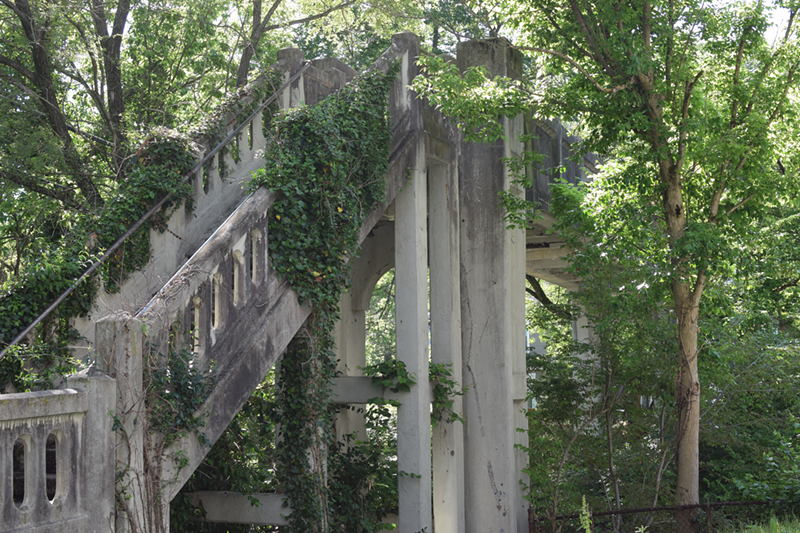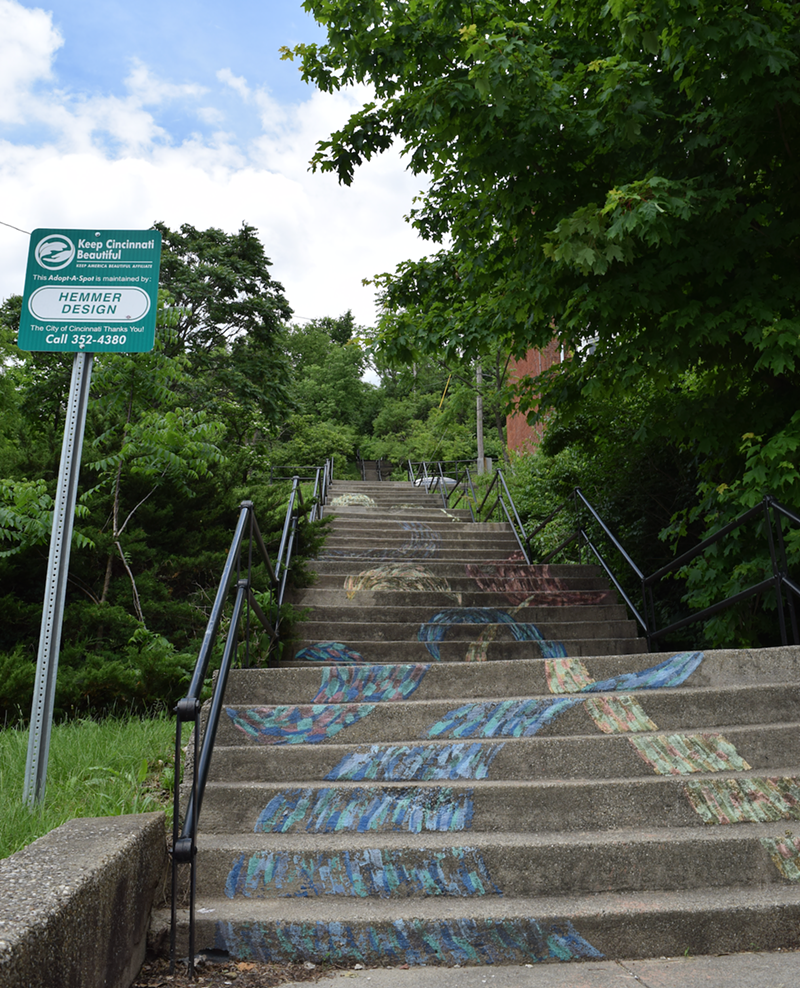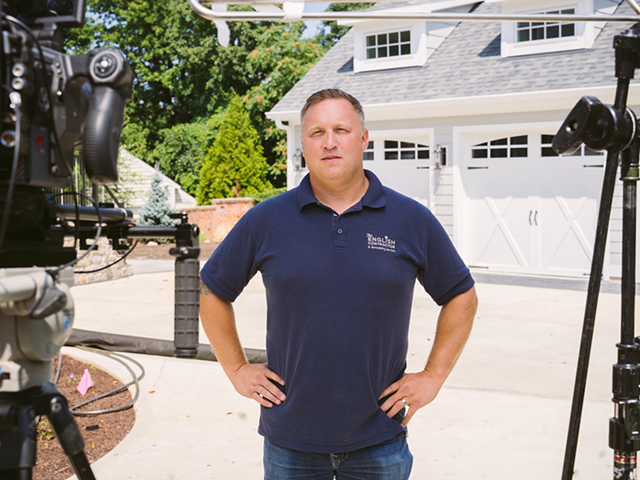Over 400 sets of steps carve through Cincinnati’s hillsides and valleys, threading through the city’s 52 neighborhoods and making space for pedestrians to get from here to there. As a result of the coronavirus pandemic, social distancing measures have left many with a renewed interest in exploring Cincinnati’s outdoor spaces, including its many urban staircases.
In a preface to her book Walking the Steps of Cincinnati, which was originally published in 1998 and updated in 2014, Mary Anna DuSablon posed the question as to why the Queen City is home to so many steps. Laid out in a basin along the Ohio River, downtown Cincinnati is bordered by steep hillsides. And though it has been called the City of Hills, she argues that it’s really a “City of Valleys,” ones that were “carved in a rolling plain formed more than two million years ago.”
Cincinnatians moved from the basin and took to the hills, forming pockets of unique neighborhoods. “Toward the end of the 1800s, as various modes of transportation evolved, trolley car routes terminated at the steps, and eventually, at one of the five inclined-plane railways as well. More stairways branched out from inclines to accommodate residents on the streets underneath,” DuSablon writes.
The longest of Cincinnati’s public stairways — the Main Street Steps — tallies 354 stairs and sprawls from Over-the-Rhine’s Mulberry Street all the way to Eleanor Place in Mount Auburn.
According to DuSablon’s book, they were built expressly for that purpose — to connect the two neighborhoods, and everything that falls in between.
From the bottom, walkers can’t quite see the top. Between flights, there are brief stretches of respite that reveal stunning views, often shaded by greenery. Between slats of tree limbs, peaks of buildings, roadways and murals unfurl. At the mouth, colorful chalk-like art swirls along the concrete steps. She notes that the phrase “oxygen sickness” has been used in reference to the steep, lengthy ascent. Make it to the top and you’ll be rewarded with a pause at Jackson Hill Park.
On a recent sunny day in May, Metro Scooter owner Seth Hershey met me at the foot of the stairs on Mulberry. It’s just one of many flights featured on his Instagram account @cincystairs, which he began in November 2019.
“I was born and raised in Cincinnati and the surrounding area; anytime that we’d come into town I would always see the stairs,” he says, adding that they instilled in him a sense of adventure. He also cites the now-decommissioned old yellow lamp shades known as turtles, which once designated transit stops. An avid explorer, hiker and biker, he was fascinated by these details from an early age.
Hershey discovered many of the staircases featured on his Instagram account while riding his bike/scooter through Cincy. Even his kids will now point out staircases that blur past as they take family drives. And his documentations aren’t contained to one part of the city. Scroll through his 146 (and counting) posts and you’ll find climb-able beauties from most pockets of the Queen City.
“I love them all,” he says when asked if he has a favorite set.
“There are some that I’m like ‘Bookmark!’ because next chance I get, if my girls will put up with me, I’ll take my girls there,” Hershey says.
Each post details the intersections (and parks) at which any given staircase can be located, alongside the amount of steps Hershey counts. Of the latter — especially when tackling larger flights — he says he often has to recount. Like Walking the Steps of Cincinnati (a book that Hershey himself has read), the account may be about stairs on the surface, but more than anything it acts as a guide for followers to explore Cincinnati by way of walking.
Take to the Main Street Steps and one will notice a concrete pillar marked with a blue aluminum sign. Cincinnatians have local nonprofit Spring in Our Steps to thank for that. The signage was placed there in 2017, along with 12 other bollards along eight pedestrian paths between Over-the-Rhine and Mount Auburn.
A collaboration with the Department of Transportation & Engineering, the $20,000 project aimed to help students get to Rothenberg Preparatory Academy with ease, according to a 2017 article by CityBeat’s Steven Rosen. But really, it’s for anyone who uses the path.
Along with hosting volunteer-driven cleanups, this kind of initiative is at the core of Spring in Our Step’s (SIOS) mission. Founded in 2012, the organization has “promoted and improved walkable, public pathways to reconnect communities to the city’s greatest cultural assets.”
In a recent Zoom interview with founder Christian Huelsman — who now lives in Minneapolis — and board member John McCue, Huelsman says that in 2011 he began to notice that public alleys and stairways weren’t being maintained by the city. He later learned that much of the funding to maintain these spaces had been stripped, so the organization took it upon themselves to start cleaning up alleyways. They reached nonprofit status in 2015 and have taken on over 70 projects, focusing on what Huelsman says has altogether been almost 175 public stairways and alleys.
“These are historical walking connections in the neighborhoods for reasons that are still apparent today in the terrain,” he says. “They’re so ingrained in the communities’ accessibility without a vehicle. We find undeniable value in maintaining those connections, especially as streets and sidewalks may not be properly maintained, made accessible or repaired.”
In many cases, these stairways connect from one bus route to the next, but many are without proper signage or lighting. SIOS advocates not only for their preservation but also for their enhancement, enabling pedestrians to travel safely between parts of the city.
“Especially for a lot of transit users in Cincinnati who rely on that as their main source of transportation, if they live in a hillside neighborhood, those staircases are the best — or fastest — way to get down to the transit route they’re using consistently,” McCue says.
These spaces should function for everyone, Huelsman adds, no matter the economic background, racial or ethnic makeup of any given neighborhood. Though projects have been on pause due to the coronavirus pandemic, Huelsman says they connected with members of the South Fairmount community last year to restore access to their public stairways, some of which have been formally closed by the city due to lack of handrails, structural issues or overgrowth. With no dedicated funding to maintain them, SIOS initiated that dialogue in the summer of 2019 and had two outings in which they cleaned three different stairways.
Pre-social-distancing, they held a hillside cleanup event in February at the Fairmount Avenue Steps, which lead to Saint Clair Heights Park.
“There were fallen trees, which some white knight came through and cleared like two days before our outing,” Huelsman says of the project.
There have been multiple ongoing projects in the neighborhood, including the Lick Run Greenway Project, a landscaping initiative that will redirect water to Mill Creek, a preventative measure to keep sewage and storm water from overflowing local sewers. Huelsman says they find that investing in the neighborhood’s connectivity needs to come now while there’s a renewed interest.
McCue also mentions that the stairways are worth checking out because, if nothing else, they are unique to Cincinnati — only so many American cities are similarly home to such a large network of public staircases.
His favorite set? The Ohio Avenue Steps.
In her book, DuSablon describes them lovingly: “There is truly no more memorable or definitive picture of life in old Cincinnati than that of the Findlay Market shopper descending the fabulous Ohio Avenue Steps.” In Hershey’s post of the stairway, he counted 109 steps in total.
Exploring Cincinnati via its stairways presents a way to view parts of the city that might not be otherwise seen. It’s one of the reasons McCue got involved with SIOS to begin with — noticing the “incredible loops” in which one could walk through the Queen City, up and down its many hillsides.
“Speaking personally, I feel that the staircases derive some of the best vistas looking down into the basin from the hillside neighborhoods,” McCue says. “What you can do, for example, going down the Ohio Avenue Steps and walking on McMicken and coming back into Fairview Park is a really cool walk that involves all sorts of staircases.”
One such flight is made up of 204 steps, which take pedestrians from McMicken to just south of McMillan before spilling out into Fairview Park Road. Each step is numbered with a square mosaic tile and the sides are decorated in an eye-catching floral pattern.
“I think (the staircases) are really unique and oftentimes, maybe surprisingly for some people, a beautiful part of the city,” McCue says, “and should be part of anyone’s summer plan to get to know their city better.”
Follow Seth Hershey’s explorations via Instagram @cincystairs. To get involved with Spring in Our Steps, visit their website springinoursteps.com.








